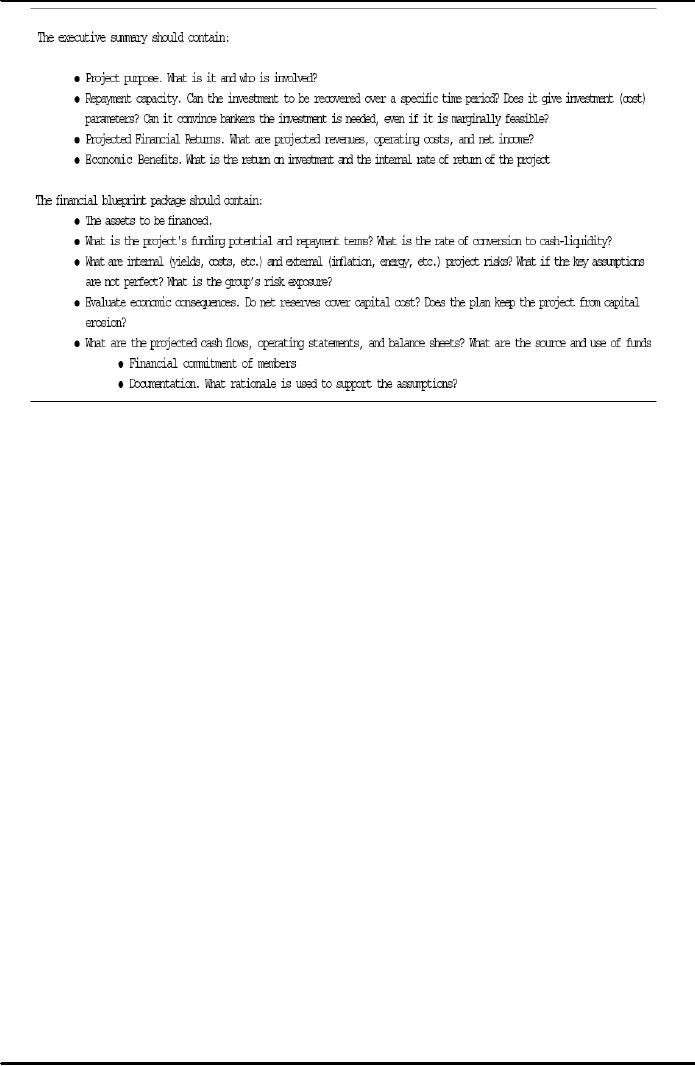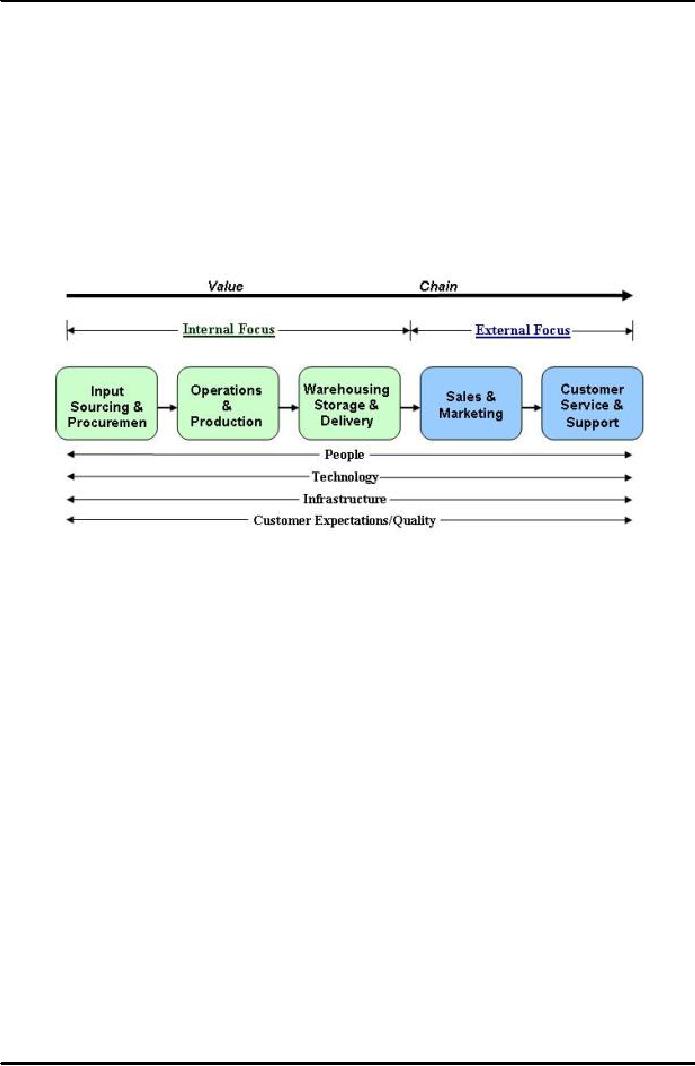 |

Project
Management MGMT627
VU
LESSON
10
PROJECT
FEASIBILITY (CONTD.)
Broad
Contents
Characteristics
of a Feasibility Study
The
Feasibility Study - What Bankers
Like to See in Them
The
Feasibility Assessment
Process
The
Process of Feasibility
Study
Conclusion
Feasibility Study
10.1
Characteristics
of a Feasibility Study:
The
feasibility study phase
considers the technical aspects of the
conceptual alternatives and
provides
a firmer basis on which to decide
whether to undertake the
project.
The
purpose of the feasibility phase is
to:
�
Plan
the project development and
implementation activities.
�
Estimate
the probable elapsed time,
staffing, and equipment
requirements.
�
Identify
the probable costs and consequences of
investing in the new
project.
If
practical, the feasibility study
results should evaluate the
alternative conceptual solutions
along
with associated benefits and
costs.
The
objective of this step is to
provide management with the
predictable results of
implementing
a specific project and to provide
generalized project requirements. This, in
the
form
of a feasibility study report, is
used as the basis on which to decide
whether to proceed
with
the costly requirements, development, and
implementation phases.
User
involvement during the feasibility
study is critical. The user
must supply much of
the
required
effort and information, and, in addition,
must be able to judge the
impact of alternative
approaches.
Solutions must be operationally,
technically, and economically feasible.
Much of
the
economic evaluation must be substantiated by the
user.
Therefore,
the primary user must be
highly qualified and intimately
familiar with the
workings
of
the organization and should come
from the line
operation.
The
feasibility study also deals
with the technical aspects of the
proposed project and requires
the
development of conceptual solutions. Considerable
experience and technical expertise
are
required
to gather the proper information, analyze
it, and reach practical
conclusions.
Improper
technical or operating decisions made
during this step may go
undetected or
unchallenged
throughout the remainder of the process.
In the worst case, such an
error could
result
in the termination of a valid project --
or the continuation of a project that is
not
economically
or technically feasible.
In
the feasibility study phase, it is
necessary to define the project's basic
approaches and its
boundaries
or scope. A typical feasibility
study checklist might
include:
�
Summary
level
�
Evaluate
alternatives
�
Evaluate
market potential
�
Evaluate
cost effectiveness
79

Project
Management MGMT627
VU
�
Evaluate
producibility
�
Evaluate
technical base
�
Detail
level
�
A
more specific determination of the
problem
�
Analysis
of the state-of-the-art technology
�
Assessment
of in-house technical
capabilities
�
Test
validity of alternatives
�
Quantify
weaknesses and unknowns
�
Conduct
trade-off analysis on time, cost, and
performance
�
Prepare
initial project goals and
objectives
�
Prepare
preliminary cost estimates and
development plan
The
end result of the feasibility
study is a management decision on
whether to terminate the
project
or to approve its next
phase. Although management
can stop the project at several
later
phases,
the decision is especially critical at
this point, because later
phases require a
major
commitment
of resources. All too often,
management review committees approve
the
continuation
of projects merely because termination at
this point might cast
doubt on the group's
judgment
in giving earlier
approval.
The
decision made at the end of the
feasibility study should
identify those projects that
are to be
terminated.
Once a project is deemed
feasible and is approved for
development, it must be
prioritized
with previously approved projects
waiting for development
(given a limited
availability
of capital or other resources). As
development gets underway,
management is given
a
series of checkpoints to monitor the project's actual
progress as compared to the
plan.
10.2
The
Feasibility Study - What Bankers
Like to See in Them:
A
cardinal rule in banking is to
borrow from a lender who
understands your business;
or, never
to
lend money on a business
project that you do not
understand. For this reason, even
though
most
groups involve their banker
early in the process, a feasibility
study is often done with
an
eye
towards explaining the project to
potential financers. Bankers, as different
clients for the
feasibility
study, can have different requirements
for the study than group
members. In many
cases,
the feasibility study is the formal
project presentation to a lender. This
section
summarizes
a feasibility study here
with the banker in
mind.
Many
groups work with bankers
with whom they already have
an established business
relationship.
This relationship could be
with another cooperative project or
with their personal
business.
This can ease the process of
obtaining financing for a
project. However even
when
working
with a banker, who is
familiar with the members, it is
important that the banker
know
and
understand the unique aspects of
cooperatives.
From
the perspective of a banker, or other perspective
financer, the feasibility
study should
contain
the information described in the table
10.1 below.
80

Project
Management MGMT627
VU
Table
10.1: Information Content of Feasibility
Study
This
does not mean that a
banker or financer is not interested in
other aspects of the
feasibility
study.
Each has their own
area of interest and concern; however,
the following will be
needed
for
most, if not all
bankers.
1.
Executive
Summary:
This
should be short, to the point, yet
still complete. If the banker cannot read
the
summary
and understand the basics of the project
the odds are that project
will receive
financing.
This should contain:
�
Project
purpose: What
is the project and who is
involved?
�
Repayment
possibility: Does
the study show the ability of the
investment to be
recovered
over a specific time period?
Does it give investment (cost)
parameters?
Can
it convince bankers the investment is
needed, even if it is marginally
feasible?
�
Projected
Financial Returns: What
are the projected financial
scale, the revenues,
and
the operating costs? What is net the
income?
�
Economic
Benefits: What
are the Return on Investment
(ROI) and the Internal
Rate
of
Return (IRR) of the
project?
2.
The
Financial Package
Blueprint:
The
banker needs to clearly see
what resources the group
wants from the bank.
The
bank
will require information to calculate
potential project risk and the
bank's exposure
for
any monies loaned to the group.
They also want to know the
financial commitment
to
the project from the members.
This blueprint should
contain the following
elements:
�
Characteristics
of assets to be financed.
�
Expected
rate of conversion to cash-liquidity
What is the project's funding
potential
and what repayment terms will be
required?
�
Risk
evaluation data What
are internal (yields, costs,
etc) and external (inflation,
energy,
etc) project risks? What if the
key assumptions are not
perfect? What is the
bank's
exposure?
�
Evaluating
Economic Consequences Do net reserves
cover capital cost? Does
the
plan
keep the project from capital
erosion?
81

Project
Management MGMT627
VU
�
Financial
Forecast What are the
next three years projected
cash flows, operating
statements,
and balance sheets? What are
the source and use of funds?
�
Documentation
What rational is used to support
the assumptions?
10.3
The
Feasibility Assessment
Process:
It
is often suggested that
feasibility studies should
encompass at least two
assessments:
�
Technical
feasibility
�
Economic
feasibility
The
technical feasibility embodies an
assessment of the physical, technical and
technological
dimensions
of the project while the economic
feasibility assesses the project's
economic
viability
within its defined
domain.
Figure
10.1: The Value Chain
Approach to Feasibility
Assessment
The
value chain approach (shown in
Figure 10.1 above) allows
the two assessments to be
embedded
into a single initiative,
facilitating an increased understanding
and appreciation of the
domain's
effects on the different stages from
input sourcing and procurement to
customer
service
and support. It also facilitates an
appreciation of the resources,
technology, customer
expectations
and infrastructure required for the
initiative to succeed, allowing an
assessment of
their
level and depth at each
subsequent stage in the value
chain.
10.3.1
Input Sourcing and
Procurement:
We
begin conducting the feasibility of the
business initiative from the
logical point in
the
value chain, i.e., input
sourcing and procurement. The
technical dimension of the
analysis
at this stage encompasses
the availability of the required
inputs in the
appropriate
levels of quality and quantity.
The assessment of availability
involves an
evaluation
of cycles and trends for
both quantity and quality of the
inputs. We are also
interested
in the physical movement of the inputs
from their origination
points to the
facilities
where they will be processed.
Different sources of supply
are evaluated for
their
quality and quantity as well
as cycles/trends in these characteristics. If
specific
human
resources and technologies are
required to facilitate the effectiveness of
the
input
sourcing and procurement stage, their
availability is assessed within the
domain of
the
project. Likewise, the infrastructure
support for effectively procuring
inputs from
origination
points to processing facility is
also assessed.
The
economics of input sourcing and
procurement emanates directly from the
technical
assessment.
The prevailing market prices
of inputs as well as costs
associated with the
procurement
are assessed at the input
sourcing and procurement stage. The
objective is
82

Project
Management MGMT627
VU
not
to determine the price but the range of
prices that have been
typical in the domain
over
a reasonable period of time to
allow for the capture of the trends
and cycles in the
prices.
The price trends and
cycles can be matched against the
quantity and quality
trends
and cycles to provide insights
into potential bottlenecks in the
input sourcing and
procurement
function of the business initiative
under consideration.
10.3.2
Operations and Production:
The
transformation of inputs into outputs
occurs at the operations and production
stage
of
the value chain. This is
also the stage that will
generally absorb the lion's
share of
the
investment capital. Therefore,
from the capital resource
allocation perspective, the
feasibility
requirements at the operations and production
stage must be conducted
with
all
the diligence necessary to address
all the requisite
issues.
The
objective of the technical feasibility
assessment at operations and production
stage
of
the value chain is to determine if the
technology being envisaged for the
proposed
project
is suitable for the desired quantity and
quality of product the project
wants to
present
to the marketplace. It also seeks to
determine if the equipment and
its
associated
technologies are at the appropriate
operational scale. Within the
value chain
framework,
the feasibility assessment of the operations and
production technologies is
conducted
by laying out the physical
process from input receipts to
packaging and
transfer
to storage and warehousing and/or
delivery.
Because
of the level of specialized knowledge
required to do justice to the
operations
and
production technical aspects of the
feasibility assessment, it is pertinent
that the
professionals
with the required knowledge and
experience are recruited to provide
the
intellectual
content for the process. It is important
that you do not lock
yourself into a
technological
jam by myopically focusing
only on a single technology.
Instead, you
must
encourage your engineering and
technical professional input
providers to provide
you
with the full range of their
knowledge about the technologies and
equipments
available.
You also need to assess the
physical layout of the equipment
and its impact
on
operational efficiency. These
professionals must also be encouraged to
provide
insights
into how the different
technologies compare with
respect to the number of
people
and their requisite skill
levels required to operate them from
beginning to end as
well
as their attendant operational inputs
electricity, natural gas or
gasoline,
maintenance
protocols and shut down
protocols, availability and turnaround
of
technical
support, etc.
The
previous information provides the
foundation for the economic assessment of
the
alternative
technical solutions that can
be used in the production process and
their
attendant
operational requirements. The technical
efficiencies of the alternative
technologies
should be weighed against their economic
efficiencies to determine
their
overall
effectiveness in the project's feasibility.
The best sources of the economic
data
to
support the assessment of the technologies
and operations are the suppliers of
the
equipment.
Such
primary data can be
collected by providing a detailed
description of your
product
to
potential suppliers in a Request for
Quote (RFQ) offer. The
principal advantage of
using
a Request for Quote (RFQ) is to
improve your knowledge of
alternative solutions
which
you may be unaware of,
should you settle on the supplier
you know. Given the
rate
of technical obsolescence, it is
imperative that capital investments in
technologies
are
made to maximize their
longevity given technical and economic
efficiency
considerations.
You should not overlook the
alternative of not making
direct
investments
in operations and production technologies,
but seek to assess
the
possibilities
of allying with a company with
existing processing and operation
capacity.
83

Project
Management MGMT627
VU
The
technical nature of the operations and
production stages of the
feasibility
assessment
requires that unbiased people who
are knowledgeable of the processes
are
hired
to help review the responses to the
Request for Quote (RFQ). You
should arrange
for
the responding suppliers to make presentations so
you and your consultants can
ask
the
necessary questions. Although this
process can be cumbersome and
time
consuming,
it is worthwhile if the equipment,
buildings and other operational
inputs are
a
significant component of the proposed project's
capital outlay.
10.3.3
Warehousing, Storage and
Delivery:
Generally,
agricultural value-added products are
stored or warehoused prior to
delivery
to
customers. Therefore, the feasibility
analysis should assess the implications
of
warehousing,
storage and delivery systems
for the project. It is important
that the
feasibility
study assesses alternative
sources of warehousing and
storage from
owning
facilities
to renting facilities to strategic
alliance with others. The
objective of these
alternatives
is to provide the project with
realistic alternatives for
consideration if the
project
is found to be feasible. The
feasibility assessment should
not only focus on the
physical
facilities but also on the
management technologies of warehouse and
storage
facilities
management. The product
tracking systems that
facilitate maximization of
space
utilization and turnover are
critical components of the assessment
process.
Additionally,
available infrastructures to support the physical
movement of products to
warehouses
or storage, and from there to customers,
must also be assessed.
For
example,
transportation systems may
influence how consumer ready
products can be
shipped
to improve processor
efficiently.
The
economics of the physical buildings,
location, infrastructure, technologies
and
other
associated resources are
brought to bear on the technical
options to ensure that
the
most
technically efficient and
economically effective alternatives
qualify for
consideration.
The best sources of
technical and economic information are
suppliers of
warehousing
and storage services. Trucking and
rail companies are often
very
forthcoming
in providing information on delivery
charges for specific products
from
certain
locations to certain destinations. The
accuracy of the data supplied by
these
service
suppliers is dependent on the clarity and
precision of the input information
they
need
to calculate their estimates. Thus, the
stepwise process of gathering
information is
important
because it provides the requisite
information that feeds into
future steps.
10.3.4
Sales and
Marketing:
Marketing
and sales are often
taken for granted in feasibility
studies. However,
they
provide
a direct insight into the
project's potential market and the
Structure,
Conduct
and
Performance (SCP) characteristics
of the players within the industry.
Therefore,
the
sales and marketing
feasibility assessment bridges the
intra-firm feasibility
dimensions
(those inside the firm) with
the extra-firm feasibility dimensions
(those
outside
of the firm).
The
conceptual backbone for the Structure, Conduct and
Performance (SCP) is the
assessment
of the demand and supply conditions of
the product and the behavior of
the
other
firms in the industry. The
supply and demand conditions
should cover the size
and
scope economies in the industry,
seasonality and trends, availability and strength
of
substitutes
to the product, industry growth
rates and demand
elasticities.
Industry
(market) structure refers to the number and size of
the firms (products) in the
industry
(market) that you intend to
enter. Industry conduct describes the
pricing
behavior
and price discovery mechanisms
used by firms in the industry. In
addition, it
84

Project
Management MGMT627
VU
assesses
product distribution mechanisms and
available channels as well as
promotional
initiatives
that are used in the
industry. The intensity of
research and development and
the
extent of legal tactics in the
industry all provide
indications of the depth of the
transaction
costs emanating from the conduct of firms
in the industry. Finally, the
industry
performance assesses the profitability of
firms in the industry. This
requires
information
on prices, product quality, technical
progress and industry
capacity
utilization.
10.3.5
Non-Market Factors:
A
technically and economically feasible
project can fail when
confronted with
certain
government
policies and/or regulations.
Therefore, feasibility studies
should assess the
existing
and/or planned regulatory
initiatives that impinge on the
project. For example,
environmental
regulations that are in place and
their technical and economic
compliance
effects on the project must be analyzed to
assess their implications
for
technology,
location, and other decisions. Similarly,
there is need to assess the
implications
of specific policies targeted to the
industry of interest and evaluate
changes
in
these policies. For example,
policies that offer
significant competitive advantage
to
the
industry but are subject to
change by administrative fiat
need to be assessed for
the
potential
effect on the viability of the proposed
project.
The
results of the foregoing analysis form
the backdrop for assessing the
feasibility of
your
product in the defined market
domain. It helps you position
your product within
the
context of what already exists and
how it may differentiate
itself to ensure its
competitive
advantage. The characteristics that
are engineered into the product, as
well
as
the pricing, promotion and distribution
or placement opportunities are all
influenced
by
a clear understanding and appreciation of the
industry's Structure, Conduct and
Performance
(SCP).
10.3.6
Data Collection:
Information
on industry structure and performance may be
obtained from various
government
statistics, such as those
developed and maintained by the Department
of
Commerce.
These databases offer
information on the number of firms and
employees,
average
wages and benefits, total
value of shipments, gross margins,
etc. In addition to
government
databases, specific industries
also collect their own
statistics and
commission
reports that may be purchased.
Interviews with specific
industry experts
can
also be a major information
source. Similarly, significant
information may be
obtained
from industry news in the
main media or in industry-specific
publications. For
example,
when industry news reports
indicate that plant closures
are increasing, it may
be
logically extrapolated that
industry capacity is high and
utilization is low.
The
implication
of this for performance is often
easily inferred for
undifferentiated or
commodity
industries. Marketing and promotional
information may be obtained
from
special
publications focusing on product
marketing and promotions. These
function-
specific
publications often discuss the
successful initiatives and can
provide significant
insights
into the approaches used in
particular industries. Another
source of
information
on industries is academics publications
and government documents.
Because
Structure, Conduct and Performance (SCP)
issues present important
policy
implications,
they are the subject of study in
many government and
academic
documents
and they can provide
important and significant insights on
market structure,
conduct
and performance situation in many
industries.
For
agricultural value-added initiatives,
secondary data can suffice
for the input
sourcing
and procurement segment of the
feasibility assessment. The
sources of these
secondary
data include industry and trade
publications as well as statistics of
industry
85

Project
Management MGMT627
VU
associations.
Additionally, a number of government
departments collect, analyze and
publish
some of these data. In special
cases, primary data
collection may be
necessary
and
this may be done through
formal surveys or interviews. For
example, different
suppliers
may be asked to provide
information on their products prices,
quantities and
qualities
as well as the stability of their
quotes, e.g., the frequency with
which they
change
their prices, quantities and quality. In
most cases, when potential
suppliers feel
the
project initiative is credible,
they will invest their
best efforts to provide the
required
information.
It
is important to note that the
effective collection of primary
data can be expensive
and
time
consuming. An alternative to primary data
when secondary data is not
neatly
available
is to pull them together from
different sources, ensuring
that measurements
and
definitions are similar
across sources. It may
sometimes be necessary to
transform
data
from different sources to comparable
units to attain the necessary
congruence
required
for
analysis.
10.3.7
Customer Service and
Support:
What
do customers want? Ask them.
The final step in the value
chain framework to
feasibility
assessment is finding out
what customers needs are
not being satisfied by
the
current
marketplace. The purpose of this is to
determine if the proposed project's
offer
stand
to make a difference in satisfying
customer needs. The results
will provide a
credible
input into the project's
product differentiation index
and allow the proponents
to
identify the appropriate placement and
promotional options to employ.
Customer
service
and support research allow the proposed
project to gain insights
into the nature
and
structure of its potential market. It
can develop market segments
at this step,
allowing
it to refocus other components of the
initiative or revisit earlier
steps in the
feasibility
assessment process. Since customers
are the final arbiters on the success of
a
product,
assessing how the project
addresses their unmet needs is
fundamental to the
project's
economic feasibility.
Information
for the customer segment of the
feasibility can be obtained
from reviewing
consumer
publications and industry
publications for general assessment of
needs and
how
the project's offering addresses them.
Direct information may be
obtained by
conducting
focus group interviews, surveys and/or
interviews. While these
initiatives
can
be expensive, they are
worthwhile if technical and economic
assessments thus, far
are
supportive of the project and more
information is required to make the
decision.
For
this reason, it is prudent
for the customer segment to be where it
is in the value
chain,
i.e., the end. However, it is important
to remember that the process described
in
this
document is hardly linear but rather
iterative, using information
from one stage to
dig
deeper into or gather new
information gathered from an earlier
stage.
10.3.8
The Decision
Recommendation:
The
purpose of a business feasibility
study is to make a decision about
whether to
proceed
with a particular business
opportunity. It provides the general
internal and
external
value chain conditions that
confront the business initiative
and evaluates the
proposed
initiative's ability to be economically
viable if it is found to be technically
and
operationally
feasible. Therefore, the emphasis on the
recommendations resulting from
the
feasibility study is economic or
financial.
The
easiest approach to the economic decision is to gather
all the information at the
different
stages of the value chain
and identify those that
require capital
expenditure
and
estimate these expenditures.
Additionally, identify the different
types of people and
skills
required to operate each stage of the
value chain and determine
what their wages,
86

Project
Management MGMT627
VU
salaries
and benefits will be.
Finally, identify other
project related costs such
as
infrastructure
development or improvements, occupancy,
advertising and promotion,
office
supplies and utility as well as fees and
municipal or state development
taxes
specific
to the project. Next, using the
production capacity, projected
market share
growth
rates and the estimated market size, in
conjunction with price
information
collected
in the various stages of the feasibility
study; develop a projected revenue
or
sales
statement. It is important to
specifically define all
assumptions that drive
the
income
and cash flow projections, e.g., the
mean or median wages, salaries
and
benefits,
current price and industry
average of plant operating
capacity, etc. Also,
analyze
all the data that were
collected to determine their
ranges, adjusted for special
circumstances
and use these to conduct the
sensitivity analysis on the economic
outcomes
of the project.
10.3.9
Cost and Revenue
Projections:
The
cost and revenue projections together
allow the development of the net cash
flow
emanating
from the business over the
projected time frame. This
statement can then be
subjected
to capital investment analysis by selecting a
reasonable discount rate
and
estimating
the Net Present Value (NPV)
and/or estimating the Internal
Rate of Return
(IRR)
associated with the projected
cash flow. A positive Net
Present Value (NPV)
implies
an economically feasible project and the
larger the positive Net
Present Value,
the
more economically feasible the project,
assuming the technical and
operational
feasibility
can be assumed. If the project owners
are making a decision based
on the
Internal
Rate of Return, then they
need to determine their
required rate of return and
compare
it to the estimated Internal Rate of
Return. If the Internal Rate of
Return (IRR)
exceeds
their required rate of return, then the
project is economically feasible. On
the
other
hand, if the estimated Internal Rate of
Return is less than the
proponents' required
rate
of return, then the project is
deemed economically infeasible even if it
is both
operationally
and technically feasible.
10.3.10
Sensitivity Analysis:
It
is important that the project
cash flow is subjected to the full range
of sensitivity
analysis
under a range of prices based on data
that is collected for the
feasibility study.
This
will provide the full range of
conditions that support the feasibility
of the project.
The
wider the band of feasible outcomes
results from varying the
critical assumptions,
the
more confident you can be
about the viability of your
project. On the other hand, if
the
band of feasibility is narrow vis-�-vis
the critical variables, then
the project's
viability
is more susceptible to uncertain shifts in
its marketplace. For this
reason, it is
emphasized
that the sensitivity analysis of the
feasibility analysis be conducted over
the
full
range of the project's industry
possibilities. These possibilities
may be divided into
three
blocks worse case,
normal case and best
case scenarios. Additionally,
the
sensitivity
analysis must be conducted for different
scenarios, for example, best
price
with
worst demand conditions.
This provides insights into
the critical bottlenecks to the
project's
viability and allows the proponents to
assess the decision
recommendations
within
a more informed framework.
10.4
Conclusion:
The
purpose of a feasibility study is to
help assess the viability of a
business proposition,
technically,
operationally and economically. The
value chain framework for
conducting
feasibility
studies has the unique advantage of
laying out the project in
its logical
configuration
from input procurement to customer
service and assessing the technical,
operational and
economic
feasibility at each stage, and
finally putting it all
together to assess the total
project
feasibility.
The advantage in this approach is
revealed in exposing the bottlenecks to
feasibility
87

Project
Management MGMT627
VU
along
the value chain so they can
be assessed for possible improvement.
The iterative nature of
the
approach is also helpful because it
allows the analyst to revisit
previous steps when
information
from latter steps suggests
the need. In the end, the logical and
step-wise process for
conducting
feasibility assessment within the
value chain framework helps
enhance transparency
of
the analysis and provide the foundations
for better decisions.
The
report was laid out to
reflect expectation of presentation of a
good feasibility report.
Thus,
it
is expected that such a report
will cover the input
sourcing and procurement, operations and
production,
warehousing, storage and delivery.
These three cover the logistics
aspects of the
production
process and draws on the infrastructure
conditions, technological and
technical
realities,
human resource availability, capabilities
and skills and customer expectations
of
quality
associated with the product.
Marketing, sales and
customer service take the analysis
into
the project's external domain to
assess industry structure, conduct and
performance
characteristics
as well as regulatory hurdles that
confront the project. The
customer service and
support
component demand of the analyst to
determine the specific needs of
customers that may
be
addressed by the project's offering
and estimate the product
differentiation index.
Pulling
all the information together
into financial units, the
analyst can build the
investment,
operational
costs and revenue projections over a
reasonable time frame and estimate the
Net
Present
Value (NPV) and/or the
Internal Rate of Return
(IRR) to facilitate making
decision
recommendations.
A project returning a positive
Net Present Value is deemed
feasible and the
larger
the Net Present Value the
better. Project analyst
needs to determine the required rate
of
return
that investors in the project would
deem acceptable and compare
it to the Internal Rate of
Return
to determine the project's feasibility.
If the former is lower than the
estimated Internal
Rate
of Return, then the project is
judged to be feasible and vice
versa.
88
Table of Contents:
- INTRODUCTION TO PROJECT MANAGEMENT:Broad Contents, Functions of Management
- CONCEPTS, DEFINITIONS AND NATURE OF PROJECTS:Why Projects are initiated?, Project Participants
- CONCEPTS OF PROJECT MANAGEMENT:THE PROJECT MANAGEMENT SYSTEM, Managerial Skills
- PROJECT MANAGEMENT METHODOLOGIES AND ORGANIZATIONAL STRUCTURES:Systems, Programs, and Projects
- PROJECT LIFE CYCLES:Conceptual Phase, Implementation Phase, Engineering Project
- THE PROJECT MANAGER:Team Building Skills, Conflict Resolution Skills, Organizing
- THE PROJECT MANAGER (CONTD.):Project Champions, Project Authority Breakdown
- PROJECT CONCEPTION AND PROJECT FEASIBILITY:Feasibility Analysis
- PROJECT FEASIBILITY (CONTD.):Scope of Feasibility Analysis, Project Impacts
- PROJECT FEASIBILITY (CONTD.):Operations and Production, Sales and Marketing
- PROJECT SELECTION:Modeling, The Operating Necessity, The Competitive Necessity
- PROJECT SELECTION (CONTD.):Payback Period, Internal Rate of Return (IRR)
- PROJECT PROPOSAL:Preparation for Future Proposal, Proposal Effort
- PROJECT PROPOSAL (CONTD.):Background on the Opportunity, Costs, Resources Required
- PROJECT PLANNING:Planning of Execution, Operations, Installation and Use
- PROJECT PLANNING (CONTD.):Outside Clients, Quality Control Planning
- PROJECT PLANNING (CONTD.):Elements of a Project Plan, Potential Problems
- PROJECT PLANNING (CONTD.):Sorting Out Project, Project Mission, Categories of Planning
- PROJECT PLANNING (CONTD.):Identifying Strategic Project Variables, Competitive Resources
- PROJECT PLANNING (CONTD.):Responsibilities of Key Players, Line manager will define
- PROJECT PLANNING (CONTD.):The Statement of Work (Sow)
- WORK BREAKDOWN STRUCTURE:Characteristics of Work Package
- WORK BREAKDOWN STRUCTURE:Why Do Plans Fail?
- SCHEDULES AND CHARTS:Master Production Scheduling, Program Plan
- TOTAL PROJECT PLANNING:Management Control, Project Fast-Tracking
- PROJECT SCOPE MANAGEMENT:Why is Scope Important?, Scope Management Plan
- PROJECT SCOPE MANAGEMENT:Project Scope Definition, Scope Change Control
- NETWORK SCHEDULING TECHNIQUES:Historical Evolution of Networks, Dummy Activities
- NETWORK SCHEDULING TECHNIQUES:Slack Time Calculation, Network Re-planning
- NETWORK SCHEDULING TECHNIQUES:Total PERT/CPM Planning, PERT/CPM Problem Areas
- PRICING AND ESTIMATION:GLOBAL PRICING STRATEGIES, TYPES OF ESTIMATES
- PRICING AND ESTIMATION (CONTD.):LABOR DISTRIBUTIONS, OVERHEAD RATES
- PRICING AND ESTIMATION (CONTD.):MATERIALS/SUPPORT COSTS, PRICING OUT THE WORK
- QUALITY IN PROJECT MANAGEMENT:Value-Based Perspective, Customer-Driven Quality
- QUALITY IN PROJECT MANAGEMENT (CONTD.):Total Quality Management
- PRINCIPLES OF TOTAL QUALITY:EMPOWERMENT, COST OF QUALITY
- CUSTOMER FOCUSED PROJECT MANAGEMENT:Threshold Attributes
- QUALITY IMPROVEMENT TOOLS:Data Tables, Identify the problem, Random method
- PROJECT EFFECTIVENESS THROUGH ENHANCED PRODUCTIVITY:Messages of Productivity, Productivity Improvement
- COST MANAGEMENT AND CONTROL IN PROJECTS:Project benefits, Understanding Control
- COST MANAGEMENT AND CONTROL IN PROJECTS:Variance, Depreciation
- PROJECT MANAGEMENT THROUGH LEADERSHIP:The Tasks of Leadership, The Job of a Leader
- COMMUNICATION IN THE PROJECT MANAGEMENT:Cost of Correspondence, CHANNEL
- PROJECT RISK MANAGEMENT:Components of Risk, Categories of Risk, Risk Planning
- PROJECT PROCUREMENT, CONTRACT MANAGEMENT, AND ETHICS IN PROJECT MANAGEMENT:Procurement Cycles